Submachine gun HAFDASA C-4 (Argentina)
Recall that Hispano-Argentina Fábrica de Automóviles SA or HAFDASA was originally engaged in the production of cars. In the mid-thirties, the company decided to learn a new direction for itself in the form of small arms. Soon there was a project in which designer Roris Rigo and his colleagues copied one of the foreign machine gun pistols. A few years later, in 1938, the design team presented a number of new designs. This line includes a compact submachine gun C-2 and two "full-size specimens", including a product called the C-4.

General view of a C-4 submachine gun with a wooden butt. Photo Zonwar.ru
Designations of all new projects were notable for simplicity. The letter “C” meant “Criolla” - “native” or “local”. The figure pointed to the project number. So, under the name C-1 featured a copy of a foreign sample, and its own Argentine small submachine gun was the second in the lineup. Full-size submachine gun for the army had the fourth number. Moreover, in the well-known notation there is no triple. Whether the C-3 project existed is unknown. Information about its development is not available. In relation to the submachine guns of the company HAFDASA, the designation Ballester-Rigaud is often used, formed by the names of the chief designer Roris Rigo and the director of the enterprise Arturo Balester.
In all the new projects presented in 1938, the designers headed by R. Rigo used the same ideas, probably peeped from foreign colleagues. Thus, from the point of view of the concept and principles of work, the new models were as similar as possible. The main differences were in size, decoration, ergonomics, etc. A curious feature of the family was the presence of two modifications of each sample. One of them was supposed to use the Parabellum 9х19 cartridge, while the second was intended for .45 ACP ammunition.
In terms of overall layout, the HAFDASA C-4 submachine gun was similar to other models of its class, created abroad. This product had a relatively long barrel, fixed in a receiver of complex shape. Under the latter were placed box magazine and pistol grip. Depending on customer requirements, weapons could be equipped with a folding or fixed butt. In connection with the dimensions and layout, the C-4 product was identified as an automatic carbine.
The C-4 submachine gun in both versions for different cartridges was equipped with a rifled barrel with a length of 292 mm. When using 9-mm ammunition, the relative length of the barrel was 32,5 caliber; the barrel under the .45 ACP was noticeably shorter - 25,5 caliber. The barrel had a cylindrical outer surface near the barrel, behind which was the fins for cooling with atmospheric air. On the muzzle cut provided for the thread compensator. Next to her was the base of the front sight.
The design of the receiver used the basic ideas of the project C-2. The box consisted of two main devices. The top, which contained the bolt and return spring, had the form of a tube of great elongation. To the top right in this detail there was a window for ejection of shells. Behind him, a groove for the bolt handle was moving away from him. When assembling weapons tubular box was closed the back cover in the form of glass. The barrel and the upper tube were connected to the lower casing.
The lower part of the receiver was made by stamping aluminum sheet and differed in its complex shape. The upper bend of this unit was designed to install a tube with a barrel. Bottom provided a place for the receiver stores and pistol grip. Above the last inside the box were parts of the firing mechanism. The C-4 submachine gun received an unusual ammunition system, due to which an extension to move the magazine appeared in front of the receiver. In front of it was fixed a movable cover with a mount for the store.
New weapons received automation on the basis of the free shutter. The main part of such automation was a cylindrical bolt of sufficient mass, movably placed inside a tubular receiver. The shutter mirror had a fixed drummer. To the right of the gate was placed the cocking handle, bred through the corresponding groove of the receiver. The back of the box was given under the return-combat spring. The mass of the bolt and the characteristics of the spring were determined in accordance with the characteristics of the cartridges. As a result, weapons for different cartridges could show similar characteristics.
On the right side of the receiver, directly behind the wide receiver of the store, there was a large puck with a flag that served as a translator of fire. According to reports, the C-4 product had two modes of operation and allowed both single and bursts to fire. At the third position of the flag mechanisms are blocked. The shot was made from the open shutter.
One of the objectives of the projects of the company HAFDASA was to increase ammunition, ready for use. For this purpose, R. Rigaud and his colleagues developed special “double” stores and an unusual receiver for their use. Due to the original layout of the two types of stores could hold 50 cartridges 9x19 mm or 40 .45 ACP, but at the same time kept acceptable dimensions.
The detachable box magazine was notable for its increased cross-section and had a pair of longitudinal partitions. With the help of the latter two separate feeding units were formed with their own springs and feeders. The upper section of the store was organized as two separate feeders. Simultaneous filing of cartridges from two rows was not provided. On the front and rear walls of the store there were protrusions for fastening in the receiver.
On the receiver, in the back of the receiver, there was a rigidly fixed place for the rear ledge of the store. The front was captured by a swinging lid with a hole. Being installed in the receiver, the store could swing to the right and left relative to the submachine gun. By moving the magazine to one position, the shooter could use half of the ammunition. To use 20 or 25 other cartridges, you had to turn the magazine in the other direction.
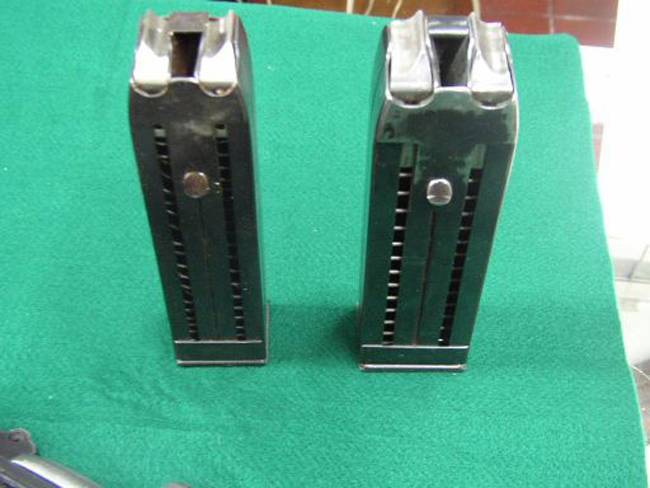
Dual shops company HAFDASA. Photo Guns.com
Submachine guns C-4 had the simplest sights. On the muzzle of the trunk, directly behind the compensator, there was a low base with a front sight. The latter had protection in the form of a pair of side plates. On the top of the receiver, outside the window for ejection of the sleeves, was an open sight. With the flip-pillar, it was possible to change the target range. The possibility of entering lateral corrections was absent.
The weapon could be completed with two options of accessories. In both cases, the submachine gun had a pistol grip of fire control, in front of which there was a trigger and a protective bracket. On the rear wall of the receiver there were fastenings for mounting a stock of one type or another. Both versions of accessories did not include the shank.
For infantry, police and other structures were offered submachine guns with a wooden butt. The latter had a quadrangular shape and was fixed directly on the receiver. The contours of the upper part of the butt provided a certain convenience of aiming. According to some reports, the attachment allowed, if necessary, to dismantle the wooden butt. At the same time, he would have to be transferred separately from the submachine gun, and the transfer of weapons to a full combat configuration was distinguished by a certain complexity.
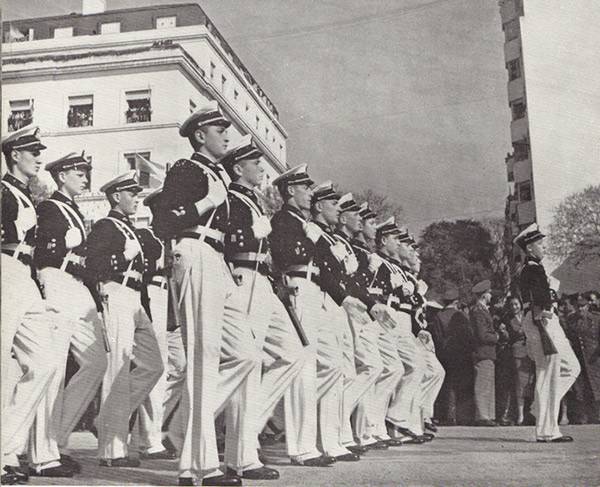
The cadets of the Naval Academy parade. Fifties. Photo Guns.com
Amphibious units proposed to use products HAFDASA C-4 with a folding butt. Such a butt consisted of a pair of longitudinal bars connected by a U-shaped shoulder rest. The first were fixed on a special hinge mounted behind the rear wall of the receiver. The butt was formed by turning down and forward, as a result of which it turned out under the barrel and box. It is important that the folded metal butt did not restrict access to the controls and did not prevent the use of weapons for their intended purpose.
All modifications of the C-4 submachine gun, regardless of the cartridge used and the butt design, had a total length of 780 mm. The length of the "landing" weapons in the folded position - 535 mm. The mass of products without cartridges did not exceed 3,2 kg. Two samples for different cartridges differed by the mass of the bolt and the power of the return-combat spring, which made it possible to obtain similar combat characteristics. The rate of fire was at the level of 600 shots per minute. The initial speed of the bullet - 380 m / s. The effective range of fire reached 150-200 m.
Hispano-Argentina Fábrica de Automóviles SA introduced its new C-4 submachine gun in the 1938 year, almost simultaneously with two other types of weapons. The sample number "4" passed the necessary tests and interested the potential customer. Interest in this weapon was shown by the Argentine armed forces. A submachine gun with a sufficiently high performance could be used in the ground forces, in the landing force, in the marines, etc.
In 1939, the army adopted a new weapon and ordered mass production. However, as far as is known, serial production did not last too long. For several years, HAFDASA handed over about two thousand submachine guns to the customer. It should be noted that in the context of this number there are certain issues. Thus, it is not reliably known to which weapon the figures cited refer to: only the C-4 submachine gun or the entire 1938 line of the year. Anyway, almost all products developed by R. Rigo were mass-produced, although not for too long and not in the largest quantities.
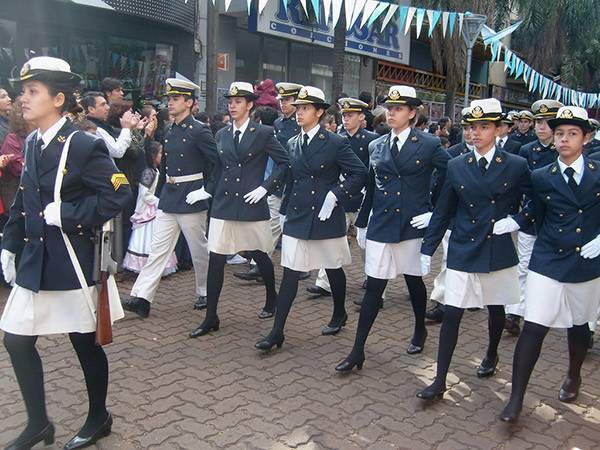
Years have passed, and the weapons of the cadets are all the same. Photo Guns.com
Due to the insufficient number of submachine guns, HAFDASA C-4 could not force out other weapons and become the main armament of the army or police. In addition, they are not even widely used and, apparently, were not used very actively. For one reason or another, the command decided not to carry out a full rearmament with the complete replacement of existing samples.
There is reason to believe that the C-4 submachine guns did not fully suit the military due to insufficient characteristics or inconvenience. So, it is known that the weapon for the landing had some operational problems. At high altitude, aluminum parts were excessively cooled and threatened the shooters with frostbite. In addition, left much to be desired fit parts, because of what the submachine guns vibrated and thundered heavily during transportation and shooting.
Any information about the combat use of products C-4 missing. This weapon had little chance of entering the battlefields of World War II, but Argentina joined the conflict too late. In addition, in the war she was represented only by naval forces. In the future, there was political instability, several times turning into open confrontation. Whether the HAFDASA submachine guns were used in such clashes is unknown.
For a certain period of time, HAFDASA C-4 submachine guns have appeared only in the context of holiday events. From the beginning of the fifties, cadets of the naval academy, armed with C-4 products, regularly participated in military parades. According to reports, the last time such weapons appeared on the parade in 2010 year.
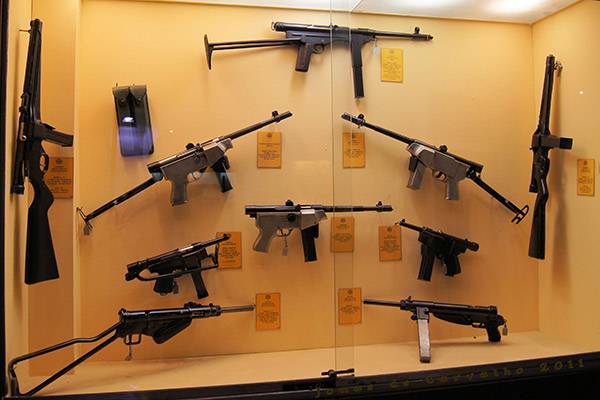
Argentine submachine guns in the museum. Products HAFDASA C-4 can be recognized by the silver receiver. Photo Guns.com
It is known that at the end of the thirties, the company Hispano-Argentina Fábrica de Automóviles SA, following the order of the military and law enforcement agencies, produced no more than two thousand submachine guns of the type C-4. Their actual number could be less if the figures cited relate to the entire line of R. Rigo's designs, presented in the 1938 year. Thus, C-4 and its "brothers" could not claim the role of the main small arms of Argentina and in such a quality have a significant impact on the combat capability of the armed forces.
Later, by the mid-forties, the Argentinean command had the opportunity to conduct a full rearmament, but the implementation of such plans was associated with other models. The emergence of a sufficient number of other weapons allowed to begin the process of writing off the development of the company HAFDASA. The number of such weapons in the units and educational institutions was constantly decreasing, although until recently it still appeared at parades. By now, probably almost all C-4 submachine guns were written off due to moral and physical obsolescence. Much of these weapons went for recycling. A number of samples were preserved and distributed among museums.
In 1938, the designers of Hispano-Argentina Fábrica de Automóviles SA, led by Roris Rigo, developed and presented several submachine guns, based on common ideas, but differing in certain features. The small-sized C-2 product did not interest the customer, while the other two “full-sized” samples were put into service. Almost simultaneously with the C-4 submachine gun for the army, a sample called the Z-4 entered the police. With all the similarities with other members of his family, he deserves a separate consideration.
On the materials of the sites:
http://guns.com/
http://forgottenweapons.com/
http://zonwar.ru/
http://forum.valka.cz/
http://nazarian.no/
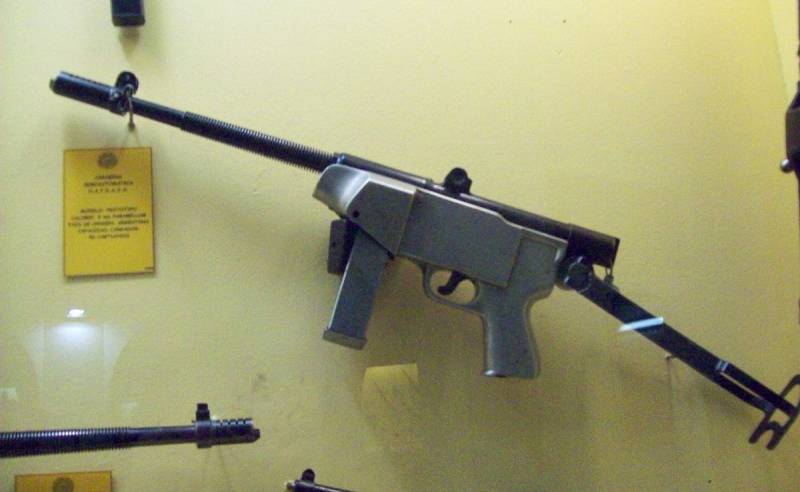
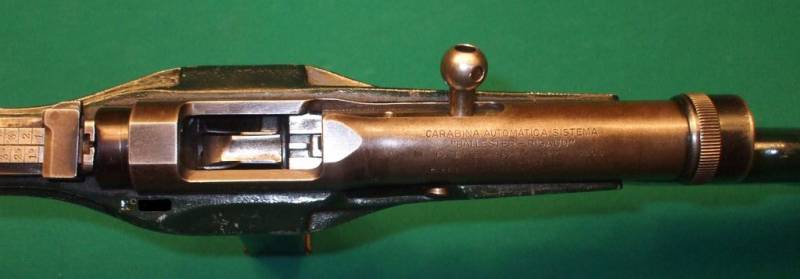
Information